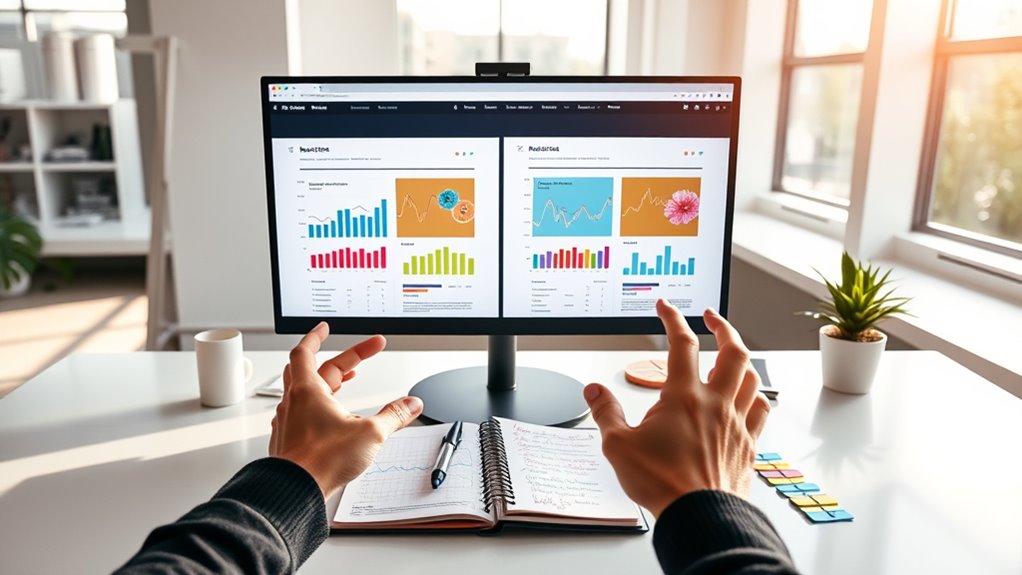To conduct A/B testing with statistics, start by defining clear goals and hypotheses, then create variations changing one element at a time. Guarantee your sample is large enough and randomly assign visitors to control and test groups to avoid bias. Collect data carefully, focusing on relevant metrics, and analyze results using confidence levels and effect sizes. This approach helps you make confident, data-driven decisions—so keep exploring further for detailed steps and best practices.
Key Takeaways
- Define clear goals and relevant metrics, such as conversion rate or click-through rate, for measurable outcomes.
- Randomly assign users to control and variation groups to ensure unbiased comparison.
- Calculate the required sample size using baseline data and MDE to achieve adequate statistical power.
- Use appropriate statistical methods (frequentist or Bayesian) to analyze differences and determine significance.
- Interpret results based on confidence levels and effect size, and implement changes only when statistically significant.
Understanding the Purpose and Types of A/B Tests

Understanding the purpose and types of A/B tests is essential for leveraging this method effectively. A/B testing helps you make data-driven decisions, reducing guesswork and increasing confidence in your choices. It’s designed to optimize user experience by testing elements like headlines, buttons, or layouts to boost engagement and conversions. Implementing AI content clusters can further enhance your testing strategy by providing targeted insights into user preferences and behavior. Additionally, it minimizes risks by allowing you to evaluate changes before full implementation. There are different types of A/B tests to suit various needs. Simple variable testing focuses on one element at a time, while multivariate testing assesses multiple changes simultaneously. Content variation strategies are crucial for understanding how different versions perform across diverse audience segments. Specialized tests target mobile apps, email campaigns, or landing pages, enabling precise optimization across channels. Knowing these types guarantees you select the right approach for your specific goals.
Planning Your A/B Test: Setting Clear Objectives and Hypotheses

Have you ever wondered how to guarantee your A/B tests deliver meaningful insights? It starts with setting clear objectives. Define your goals, like boosting conversions or engagement, and identify relevant metrics such as click-through rates or bounce rates. Understanding your target audience’s preferences helps tailor your tests effectively. Make certain your objectives are measurable, so you can accurately gauge success. Next, formulate strong hypotheses grounded in data and user research. Use a structured approach, like “If-Then-Because,” to clearly articulate what change you’re testing and why. Focus on specific modifications and anticipated outcomes. Ensure your hypotheses are testable, relevant, and feasible. A well-planned foundation ensures your tests produce actionable insights aligned with your business strategy. Incorporating user experience principles into your testing can significantly improve the accuracy and relevance of your results. Additionally, understanding divorce guidance can help organizations support employees navigating personal challenges that may affect their work.
Selecting the Right Sample Size for Reliable Results

Choosing the right sample size is crucial to guarantee your A/B test yields reliable and meaningful results. You want a sample that accurately represents your target audience to avoid skewed outcomes. Small samples can exaggerate effects or miss real differences, leading to misleading conclusions.
Larger samples improve precision, reducing variability and increasing confidence in your findings. They also boost statistical power, making it easier to detect small but meaningful effects. The projector resolution also plays a role in how clearly your results are interpreted, especially when analyzing detailed data. Additionally, understanding yoga’s holistic approach helps in designing tests that account for multiple factors influencing user behavior.
To determine the minimum size, consider your baseline conversion rate and the smallest effect you want to reliably detect, known as the Minimum Detectable Effect (MDE). Using tools like sample size calculators simplifies this process, helping you balance your desired confidence level with available traffic and resources.
Proper sizing ensures your test results are trustworthy and actionable.
Designing and Creating Variations for Testing

How can you guarantee your A/B test effectively isolates the impact of each design change? First, clearly define what aspect you’re testing, such as CTA color or headline wording. Test only one variable at a time to establish a clear causal relationship.
Develop variations by altering a single element from the control version, ensuring consistency elsewhere. Use a control version as your baseline for comparison. Understanding divorce statistics can help inform the design choices by highlighting what users might find most engaging or reassuring.
Focus on key elements like CTAs, images, headlines, UI components, and color schemes. Create variations with prototyping tools like Figma, maintaining design principles and coherence. Incorporating insights from sound healing science can also help in designing engaging and calming interfaces that enhance user focus during testing.
Randomization and Control in Experiment Setup

Randomization plays a crucial role in setting up your A/B test because it guarantees that participants or units are assigned to different groups purely by chance. This process helps reduce selection bias, ensuring the groups are comparable and balanced regarding uncontrolled variables.
By randomly allocating participants, you can confidently attribute differences in outcomes to your intervention rather than external factors. Randomization also enables the application of probability theory, which underpins statistical analysis and inference.
To implement it effectively, you might use simple randomization, blocked, stratified, or computer-aided methods, depending on your experiment’s complexity.
Including a control group provides a baseline for comparison, helping you assess the true effect of your change and ensuring your results are robust and reliable.
Choosing Between Frequentist and Bayesian Statistical Methods

When deciding between frequentist and Bayesian statistical methods for your A/B test, it’s important to understand their core differences. Frequentist statistics view probability as the likelihood of observed data given a fixed hypothesis, focusing on rejecting a null hypothesis. Understanding these foundational concepts helps clarify which approach aligns best with your testing needs.
Understanding core differences helps determine the best approach for your A/B testing strategies.
Bayesian methods interpret probability as a belief that updates with new data, allowing you to assess the probability of hypotheses directly.
Frequentist approaches are computationally faster and widely available but can be rigid, especially with peeking or small samples.
Bayesian techniques offer flexibility by incorporating prior knowledge and updating beliefs, making them suitable for adaptive testing.
Both approaches require a solid understanding of statistical principles to ensure accurate interpretation of results.
Collecting and Analyzing Data During the Test

Once you’ve chosen your statistical method, the next step is to focus on collecting and analyzing data during your A/B test. Start by monitoring real-time performance to spot trends or issues early. Track user interactions, such as click paths or navigation patterns, to gain deeper insights into behavior. Incorporate proper testing procedures to ensure the reliability of your results. Recognize early signs of a potential winner if significant differences emerge. Handle external variables like seasonal trends or technical glitches that could influence results. Address data gaps and correct inconsistencies to guarantee accuracy. Maintain data integrity by verifying that tracking systems work correctly and data is collected uniformly across groups. Regular interim analysis helps assess progress without bias, and if significant differences are detected, consider early stopping to save resources. Always prioritize data quality throughout the process. Additionally, implementing quality control measures can help detect and prevent data contamination or errors that might skew results.
Interpreting Results Using Confidence Levels and Effect Sizes

Interpreting the results of your A/B test requires understanding both confidence levels and effect sizes, as these metrics help you determine whether observed differences are meaningful or simply due to chance. Confidence levels, such as 95%, show the likelihood that your results reflect the true effect. If confidence intervals don’t overlap, it suggests a significant difference. Effect size measures how large the difference is between variations, indicating practical significance. A small effect size may be statistically significant but not impactful in real-world terms. Incorporating insights from breakfast delivery trends can help contextualize your findings within evolving consumer preferences. Combining these insights helps you decide if your results are reliable and meaningful. Remember, a high confidence level and a substantial effect size provide stronger evidence that your change truly influences user behavior.
Addressing Common Challenges and Avoiding Pitfalls

Conducting effective A/B tests requires steering through several common challenges that can undermine your results if not addressed properly. One major issue is cumulative alpha error, which occurs when testing multiple variants and increases the risk of false positives.
Effective A/B testing must navigate challenges like cumulative alpha error to ensure accurate results.
Confirming your sample size is adequate is also crucial; too small, and your results won’t be reliable. Poor data quality can bias outcomes, so clean, accurate data collection is essential. Additionally, understanding the exfoliating properties of glycolic acid can help you interpret how changes affect skin texture and overall results.
Handling high-dimensional data with many variables can lead to overfitting, so consider regularization or feature selection. Avoid common pitfalls like testing too many elements at once, running multiple tests simultaneously, or timing tests poorly.
Additionally, understanding the importance of anime culture and storytelling can help contextualize your findings and ensure your tests are relevant to your audience. Ultimately, focus on clear hypotheses and relevant traffic to ensure your results are meaningful and actionable.
Implementing Findings and Refining Future Tests

Implementing findings from A/B tests is a critical step for driving meaningful improvements, as it transforms data insights into tangible changes that enhance user experience and business outcomes. You should base decisions on statistically significant results, typically at a 95% confidence level, to avoid acting on chance. Use data to identify which variations perform best and weigh the costs and benefits before applying changes. Continuous testing creates feedback loops, allowing you to refine your website or app iteratively. Prioritize future tests based on potential impact, ease of implementation, and user segmentation to optimize resources. Each successful test informs subsequent experiments, fostering innovation. Regularly review results to ensure long-term benefits, maintaining a cycle of ongoing optimization. Incorporating essential oils for data-driven decisions can help marketers better understand user preferences and refine testing strategies for more effective outcomes. Engaging in self-awareness practices can enhance your ability to interpret test results objectively and improve decision-making processes.
Frequently Asked Questions
How Do I Identify the Most Important Variables to Test?
When you’re trying to identify the most important variables to test, start by gathering user feedback and analyzing traffic patterns to find bottlenecks.
Prioritize variables that impact user behavior the most and align with your business goals.
Consider resource constraints and past test results.
Focus on high-impact, feasible changes, and consult stakeholders for additional insights.
This approach helps you select variables that matter most for your optimization efforts.
What Are Best Practices for Segmenting Audiences During Testing?
You should start by defining clear segmentation objectives aligned with your business goals. Use relevant criteria like demographics, behavior, or location to create meaningful segments.
Develop hypotheses for each group, tailoring test elements to their preferences. Guarantee you have enough sample size and run tests long enough for reliable data.
Analyze results within segments, then refine your approach based on insights to improve future testing strategies.
How Can I Handle Multiple Testing Issues to Avoid False Positives?
Did you know running multiple tests increases false positives, risking costly mistakes? To handle multiple testing issues, you should apply statistical corrections like the Bonferroni method, which adjusts the significance threshold to control error rates.
Consider using less conservative options like the Holm-Bonferroni or FDR methods for better balance. Automating these corrections with A/B testing tools guarantees your results stay reliable and trustworthy, avoiding false positives effectively.
What Tools or Software Are Recommended for A/B Testing Analysis?
When choosing tools for A/B testing analysis, you want ones that provide clear insights and reliable data. Platforms like Optimizely and VWO offer robust analytics and easy-to-understand reports.
Google Analytics can help identify testing opportunities, while Statsig delivers precise statistical analysis.
For enterprise needs, Adobe Target and Dynamic Yield give advanced personalization and detailed insights.
Pick a tool that fits your goals, budget, and technical expertise for the best results.
How Do I Determine When to Stop an A/B Test Early?
You might think stopping early is a no-brainer when results look promising, but don’t jump the gun. You should wait until your pre-set sample size or statistical significance is achieved, using strict p-value thresholds and sequential testing.
Regular checks, clear rules, and monitoring tools help prevent false positives. Remember, rushing can lead to overestimating success, so patience and discipline are your best allies in making confident, evidence-based decisions.
Conclusion
By following these steps, you’ll turn data into actionable insights with confidence. Sometimes, the smallest tweak—like changing a button color—can unexpectedly boost your results. Trust the process, stay curious, and watch how your experiments reveal just enough to guide your next move. After all, in testing, as in life, the most surprising results often come when you least expect them, leading you to your next big breakthrough.










